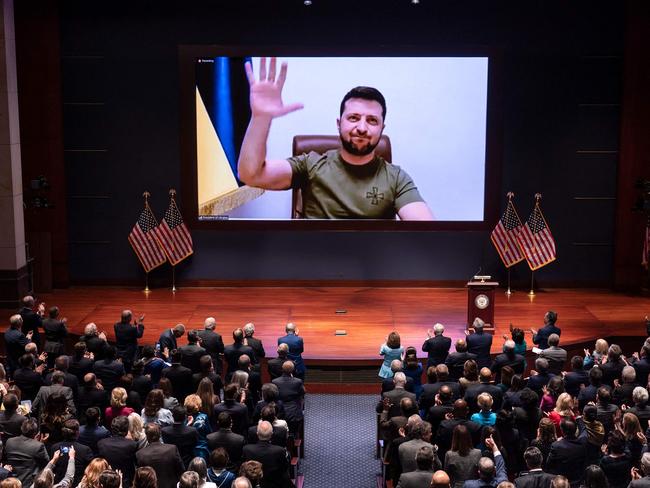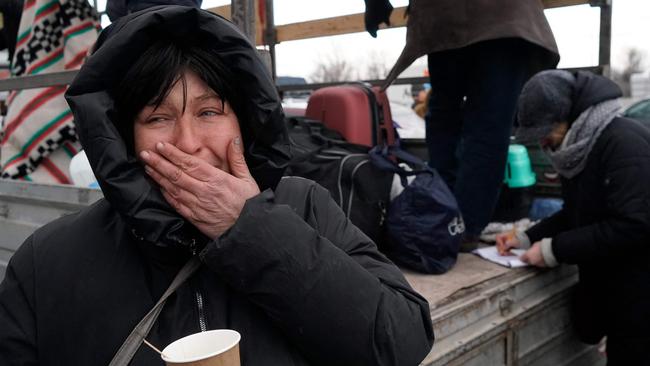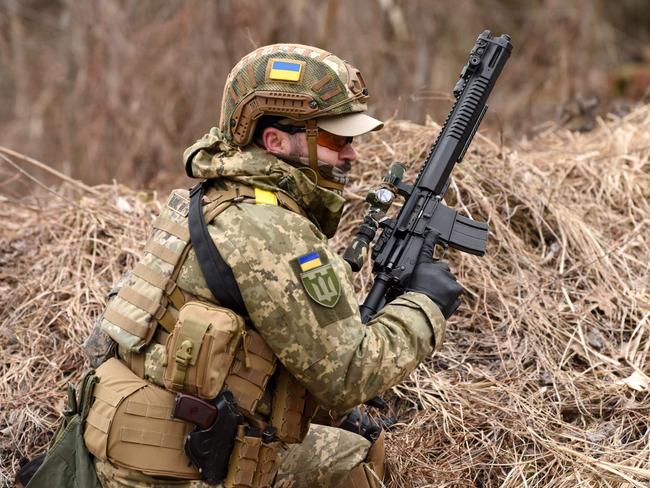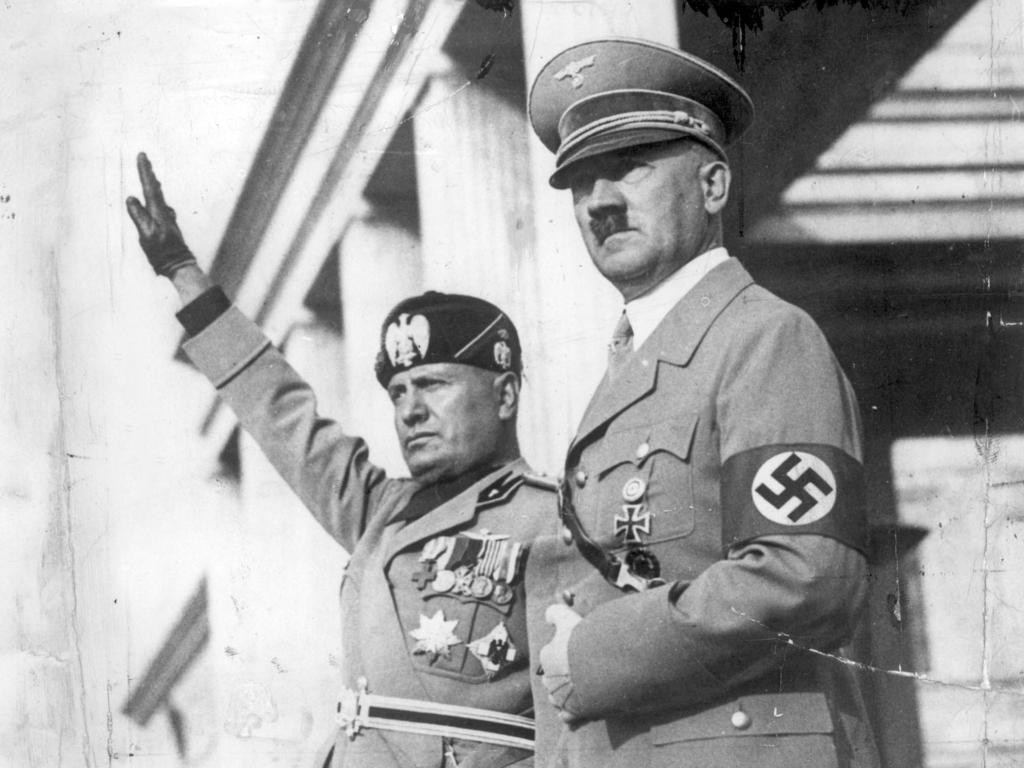How will this horrific war come to an end?
The conflict has delivered endless surprises, from the incompetence of the Russian invaders to the dogged defence of the Ukrainians. But the biggest surprise may soon be upon us.

Such an outcome might seem far-fetched as the war continues to escalate, with Russian forces stepping-up their brutal assaults on the civilians of Kyiv and other besieged cities.
But for the first time both Ukraine and Russia have softened their rhetoric on what peace might look like in Ukraine. The warring parties are now taking peace talks seriously and are inching closer to a possible deal.
Russia’s Vladimir Putin and Ukraine’s Volodymyr Zelensky are being driven by the realisation that an early negotiated peace will deliver a far better outcome for their respective countries than a prolonged and bloody war.
After more than three weeks of fighting, it is clear that neither Russia nor Ukraine can achieve their aims through a war which destroys Ukraine. Both sides increasingly see an advantage in a compromise solution.
Why? For Putin, the dream of a swift victory in Ukraine is over. The resistance by Ukrainian defenders shows that he will be unable to take Ukraine without largely destroying it, robbing him of the very prize he wanted in the first place.
If Putin inherits a destroyed Ukraine and installs a pro-Moscow puppet government, he faces a long-term Western-backed Ukrainian resistance movement, permanent economic sanctions, and a probable backlash in Russia.
“If his goal is to impose some kind of puppet regime … it’s pretty evident by the response of the Ukrainian people that they will never accept this,” says US Secretary of State Antony Blinken.
“If he tries to enforce such a puppet regime by keeping Russian forces in Ukraine, it will be a long, bloody drawn-out mess through which Russia will continue to suffer grievously,” he adds.
Putin’s snail-paced invasion has robbed him of any good options and he now has a narrow window to find an off-ramp without losing face.
For Zelensky, the price of peace, while painful, may be better than the horrific reality of watching his cities and his people being slowly ground into dust by Russian missiles.

Zelensky now knows that the US and NATO will not be sending soldiers his way. He knows the best military outcome for him is a bloody stalemate. He has no military means of reclaiming the Russian-speaking Crimea in the south which Russia annexed in 2014, or the breakaway Donbas region in the east. His only chance to save his own government and whatever remains of a sovereign Ukraine nation is to seek a negotiated settlement. Ukraine doesn’t need to win, it just needs to survive in some form.
“Ukraine has nothing to gain by continuing to fight,” writes Grayson Quay in The Week.
“There is no scenario in which Putin admits defeat, surrenders his claims on Crimea and the Donbas and withdraws with his tail between his legs.
“Like all autocrats, he can’t afford to appear weak. American hawks seem to think that the war in Ukraine is some sort of Marvel movie in which the only acceptable outcome is good guys win, bad guys lose.”
This week, despite the escalation in violence, we saw the first tentative positioning on both sides towards a negotiated solution to the conflict.
Zelensky said negotiations with Moscow were now heading in a “more realistic” direction, while Russia’s foreign minister Sergei Lavrov declared that there was now “hope for reaching a compromise”.
The most significant concession this week was Zelensky’s dismissal of the prospect of Ukraine becoming a member of NATO. In a deliberate change of rhetoric, Ukraine’s President said: “We have heard for many years about the alleged open door (to NATO), but we also heard now that we can’t enter those doors. This is the truth, and we have to simply accept it as it is. I am glad that our people are beginning to understand this.”
Putin has said repeatedly that there can only be peace if Ukraine pledges never to join NATO. Zelensky’s comments do not go that far, but they do appear to open the door for meaningful peace negotiations. From Putin’s side, there was an apparent softening this week of Russia’s previous calls for regime change in Ukraine as a condition for peace.
Moscow had previously wanted Kyiv to commit to the “demilitarisation and denazification” of Ukraine – a vague term that was widely interpreted as Putin saying he wanted to topple the pro-Western Zelensky regime.
But Putin appears to be backing away from his demand to remove Zelensky, who has become a Western hero for his spirited leadership of his besieged country.
Finland’s President Sauli Niinisto says Putin told him this week that regime change in Ukraine was not a requirement for peace.
“Putin has his list of demands; it seems that changing the government of Ukraine is not anymore on the list. When I asked him he said it (had) never been there, but nevertheless that was the understanding so far,” Niinisto said.

If it is true that Putin is no longer demanding a change of government in Kyiv, it makes a meaningful peace possible. Putin no doubt would prefer a pro-Russian regime in the capital, but a puppet government would lack legitimacy and would be the constant target of a resistance movement. By allowing Zelensky to remain in power, Putin removes the problem of Moscow having to “own” Ukraine and all of its problems after the war is over. It means Russian troops can leave the country rather than become its permanent occupiers.
But what would peace in Ukraine look like?
The answer depends on two key questions. Can Ukraine satisfy Russia’s demand that it be a neutral nation without trading away its sovereignty? And what territory will Ukraine need to abandon to secure peace?
A tentative 15-point peace plan, leaked to the Financial Times in London, proposes a Ukraine that formally declares its neutrality and accepts limits on its armed forces.
The proposal, which has not been agreed to by either side as yet, would require Ukraine to formally renounce any ambition to join NATO and promise not to host foreign military bases or weaponry.
In exchange, Ukraine would receive protection from allies such as the US, Britain and Turkey.
The head of the Russian delegation, Vladimir Medinsky, said Ukraine was proposing a model of neutrality similar to that of Austria or Sweden, acting as a “neutral demilitarised state but a government with its own army and naval powers”.
“The preservation and development of Ukraine’s neutral status, the demilitarisation of Ukraine – a whole range of issues related to the size of the Ukrainian army are being discussed,” Medinsky said.
“A neutral status is being seriously discussed in connection with security guarantees,” said Lavrov.
“There are concrete formulations that in my view are close to being agreed.”
Ukrainian presidential adviser Mykhailo Podolyak has been more wary, saying that any deal for future neutrality would need to include “clearly defined security guarantees” to keep Ukraine safe.
As David Ignatius writes in The Washington Post, any deal for a neutral Ukraine whose security is backed by Western allies would be a significant compromise for both Putin and Zelensky.
“This formula would reflect a major concession by Putin, but it could also diminish the heroic status of President Volodymyr Zelensky,” Ignatius writes. “Many Ukrainians would argue that their people didn’t fight and die to achieve neutrality.”
But Zelensky has little choice other than to accept some painful concessions if he wants to strike a peace deal with Moscow. The most painful for Zelensky would be the fact a post-war Ukraine would be a smaller country.
“The most probable endgame, sadly, is a partition of Ukraine,” says retired admiral James Stavridis, the former supreme allied commander for Europe.
Putin has demanded that as a part of any peace deal, Ukraine must formally recognise Crimea as Russian territory and the separatist Donbas region in eastern Ukraine as independent.
While both of these conditions would hurt both Zelensky and Ukrainian pride, they would not lead to much change on the ground. Russia is not going anywhere in Crimea and will continue to occupy the peninsula regardless of whether Ukraine formally recognises its ownership or not.
In the eastern region of Donbas, a separatist war has been ongoing since 2014. This is a conflict Ukraine cannot win because Russia keeps supplying weapons, training and manpower across the border to the Russian-speaking rebels.
For Ukraine to declare Donbas an independent region would rid it of an intractable conflict.
Stavridis believes that this is the most likely partition of Ukraine in any peace deal. “Putin would take the southeast of the country and the ethnic Russians would gravitate there,” he says. “The rest of the nation, overwhelmingly Ukrainian, would continue as a sovereign state.”
For Putin, this would be an outcome that he could spin into a victory for himself back home.
Putin could claim to have “saved” the Russian-speaking Donbas from Ukraine, secured Crimea as a formal part of Russia and ensured guarantees of Ukraine’s ongoing neutrality and its rejection of NATO.
But Putin may want more. His forces have all but secured the southeastern coastline of Ukraine which would give Putin a direct landlink from the Donbas to Crimea and the Black Sea. That is a strategic and commercial advantage that Putin may not be willing to negotiate away.
Another option for Putin, short of conquering all of Ukraine, would be to seek to divide the country in half down the middle. Under this scenario Russia would keep the capital Kyiv and may even take the southern port city of Odessa, cutting the new Ukraine off from the Black Sea. This would leave only western Ukraine as a much smaller and hugely diminished sovereign state, with a new capital of Lviv.

Putin’s invasion plan so far has spared western Ukraine. Although Russia launched a deadly missile attack on the western Yavoriv training base this week, Russian troops have not entered the region and show no sign of doing so.
The final option for Putin is not to cut any early peace deal but rather slowly grind Ukrainian cities into dust ahead of their eventual conquest.
Retired General David Petraeus, who commanded US forces in the Iraq and Afghanistan wars, believes Russia does not have the ability to take, much less hold, large cities such as Kyiv.
“Usually, the rule of thumb for urban warfare is that it requires at least five attackers for every defender. In this case, I’d argue it may be more than that because the Ukrainians are so resourceful. The Russians have nowhere near enough soldiers to do that even for Kyiv, much less all of the other cities.
“And so, they continue the approach they used in Chechnya, particularly with Grozny, and in Syria, particularly with Aleppo, where they depopulated the cities by the indiscriminate use of bombs,” he says.
But Petraeus says that ultimately, this would lead to “a bloody quagmire for Russia that is worse than the Soviet war in Afghanistan during the 1980s”.
“This quagmire would cause a terrible loss of life, destruction, displacement, depopulation of urban areas, a massive humanitarian catastrophe, as well as terrible losses for Russia, without a conclusive outcome for Russia.”
This inability of Russia to achieve its military aims in Ukraine makes Petraeus believe that a negotiated peace is increasingly possible.
“There could also be a negotiated settlement as both Putin and Zelensky realise that neither of them can fully achieve what it is that they want, and that both sides are suffering enormous destruction.”
It is still early days in the peace negotiations and either Putin or Zelensky could derail them in an instant. But with each passing day the logic of a negotiated peace in Ukraine makes more sense for both leaders. A destroyed Ukraine will be no use to either of them.






The war in Ukraine has delivered endless surprises so far, from the incompetence of the Russian invaders to the dogged defence of the Ukrainians. But the biggest surprise may soon be upon us. Are we about to witness an early end to this bloody conflict?